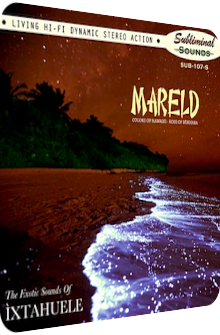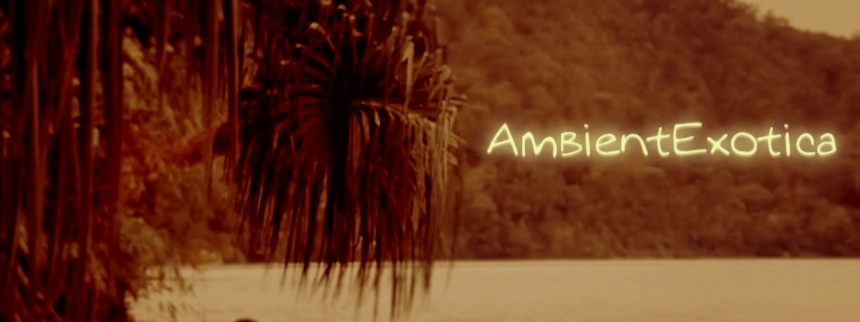
Ìxtahuele
Mareld EP
2014
The Swedish quintet Ìxtahuele has never shied away from approaching the scintillating Exotica genre in a presumably laid-back fashion… only to then reveal the utmost beautiful polyphonies and helicoidal galactosamines in their works. The band from Gothenburg started their career with the gorgeous four-track digital-only EP The Exotic Sounds Of Ìxtahuele (2012), moved on to their full-length debut Pagan Rites (2013) that revisited three of the four previously EP-only cataracts, and now comes up with another peaceful coup de main called Mareld EP.
First previewed at Tiki Oasis 2014 and subsequently graced with a purple seven-inch vinyl disc released on Stefan Kéry’s Subliminal Sounds label in September, Mareld EP is very obviously a little work which shows where the band is at. Then again, this is a deception, a connotative ploy, for this intrinsic triptych is also timeless and withrawn into itself, allowing the listener to visit its rain forests, encounter a vivacious allure and being swept away by the varied material.
From gentle driftwood over carefully Spy Jazz-flavored locales to the wonderfully clichéd dry deserts of one’s Hollywood-penetrated mind, there is much to visit over the course of approximately 12 minutes. The term mareld is the Swedish description for the phenomenon of the milky effects near the beach side when the water gleams and glows for various reasons (mermaids?). The personnel meanwhile remains largely intact, comprising of the two vibraphonists and percussionists Wictor Lind and Mattias Uneback, dedicated percussionist Johan Hjalmarsson and bassist Henrik Nilsson. New on board is pianist David Löfberg who replaces the freshly honored US expatriate Carl Turesson Bernehed. Bernehed, however, hasn't cut any bond at all and is still affiliated with the band, having composed one sparkler of this EP which is, as usual, inspected in-depth. Who could resist the tropical hue after all?
The EP is aglow right from the get-go, as verdured plankton, aqueous ashlars and rectangular blebs intermix in unison amid the eponymous title track. Mareld is written by Mattias Uneback and is a long-form track by Exotica standards, running for almost five and a half minutes. The retrogressive approach the band takes here is noticeable during the entry point already, for in lieu of field recordings, lush waves, birds and the various critters which all appear later on as the EP progresses, David Löfberg’s lactal piano glissando is unveiled. Vibraphones and even a violin carry the sumptuous melody onward, and once a majestic mixed choir enters the benthic lavabo to severely cajole the gustatory aura of freedom, insouciance and laissez-faire, this piece exudes, spawns, emanates a gorgeously laid-back tropical diorama. Jungle flutes flow like vanillarific superfluids, fibrillar bongo patterns emerge from the distance, and beyond as well as all around this nucleus are the strings, a clarinet-like woodwind instrument and an argentine yet amicable military march segue near the end. The revved up production skills and textural variety make the title track an orderly stirred melting pot of paradisiac equanimity. Ìxtahuele is now officially successful enough to invite a choir of coquettes to join their sea shanty hums. An epiphany!
Side B harbors two songs, as is often the case with seven-inch releases. Colors Of Hawaiki is another Uneback composition brought to life both by interplay and interdependence. While Mareld is eminently mellow and hammock-compatible, this second arrangement invites the listening subject to absorb many pointillistic vibraphone vesicles in-between an upbeat bongo groove. One particular vintage veil is lifted in the first few seconds as a boatswain’s ship signal is emulated by the thermal warmth of a silky flute; this kind of escapism is specifically used in many an Arthur Lyman album, and once you hear the effect in Ìxtahuele’s piece, you experience the superimposition of melancholia and nostalgia. This oneiric tribute, however, is just the beginning for a birdcall-underlined vitreous Spy Jazz-flavored sunburst of sizzling maracas, hollow drums and fusillades of eclectic piano-and-vibraphone entanglements. Once the polyphony of the vibes is further ameliorated by the piano’s pericarp, the titration process experiences its completive balance.
Colors Of Hawaiki is a swinging piece sans brass instruments, the band is capable of blending cautiously clandestine spy splinters with forested soulfulness. The melodies, while not necessarily hummable due to their saltatory nature, are always accessible in the most welcome way; they still inherit an infinitesimally labyrinthine physiognomy that makes them come closer to the improvisation skills of the Rene Paulo Group. That is the reason why I attributed the term sunburst to Colors Of Hawaiki, for its aureate aureoles are traversed by interstitial shades. Excitement ensues!
Aural floralcy, floral reality: Carl Turesson Bernehed’s The Rose Of Bukhara kisses the listener goodbye, but before this event unfolds – and becomes repetitively annihilated by a new listening session – the curious traveler is in for a seething mirage. The band ventures into the Orient, and while the notion of the term Orient is deemed unacceptable nowadays due to the implied glorification of imperialism, I use this very term in order to hopefully somewhat encapsulate the pompous mélange of Sahara winds, saffron market places, the stench of camels and the most precious of all flowers next to Cal Tjader’s Black Orchid, namely said Rose Of Bukhara. And indeed, this flute-carried piece extrapolates possessive envy in the liner notes already which state that “men have died for the Rose of Bukhara, and men will die again.”
This grim but adventurous verve is embedded via a soothing flute melody that evokes the Middle Eastern pentatonicism that is so often associated with snake charmer shawms. However, only the melody is resemblant of that notion, the texture meanwhile is that of an alto flute. Glistening vibraphone shards diffract the dreamy bass bokeh, silvery tambourines and syringa bongo stabs round off the ornate theophany known to man as the Rose Of Bukhara. Sense the scent!
When the Mareld EP has stopped, Ìxtahuele have come full circle in the short runtime of 12 minutes, having revealed important pillars – and pillows – of modern Exotica erethism. We are offered the dedicated easygoing title track Mareld with its luminescent nucleus and captivating production technique, followed by a faster paced Spy Jazz-resembling piece whose duality complements the respective force, and finally the band succumbs, if you will, to the most prototypical Exotica desert chintziness ever since Duke Ellington’s Caravan has seen the light of day in late 1936. The EP harkens back to Ìxtahuele’s first digital-only EP, but the band has obviously come a long way since 2012.
I fully admit that the Mareld EP is probably just that: a small EP in the wake of something bigger at a later point. However, the slick recording technique with all the digital advancements and whatnot does neither set back nor overly purify the material. While all three tracks are top notch, vivid and varied, Mareld is the showstopper here. No surprise, since this is the A-side, duh. But even apart from this assessment, this track shows a wider scope, a technicolor flame that is realized by classical strings and a mixed choir, be it sampled or not. Oscillating between an appetizer and a multifaceted complexion, Mareld EP lives up to the Exotica connoisseur’s demands in general… and the band’s fanbase in particular.
Exotica Review 372: Ixtahuele – Mareld EP (2014). Originally published on Sep. 6, 2014 at AmbientExotica.com.
